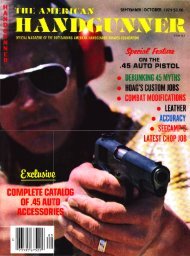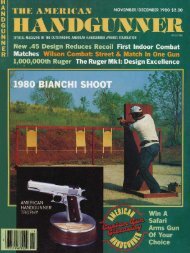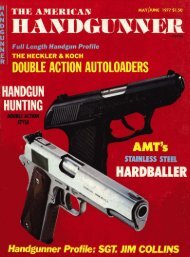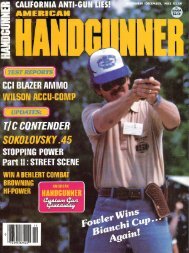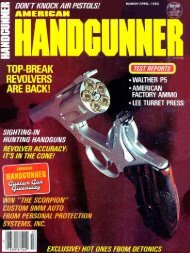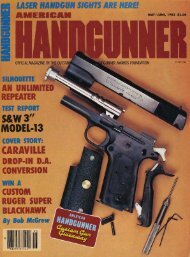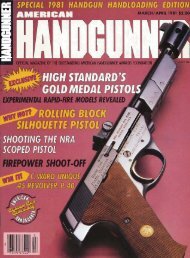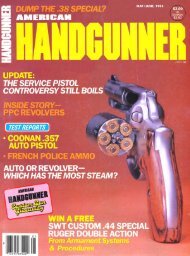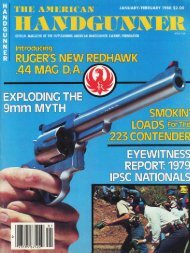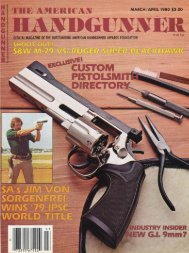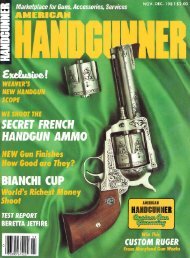American Handgunner July/August 1977
American Handgunner July/August 1977
American Handgunner July/August 1977
You also want an ePaper? Increase the reach of your titles
YUMPU automatically turns print PDFs into web optimized ePapers that Google loves.
as 'well as the position you will assume,"Ray said, explaining, "this means you willhave to determine which firing positionwill be advantageous for a particular problem.''The decision thus involves whether ornot it would be better to shoot fast andpossibly miss or shoot more slowly andscore positive hits but possibly not get offall the required rounds in time. "You haveto decide that for yourself; thus, for thenovice, always try to stay under control,and try never to waste a shot."In shooting multiple targets, Ray advisesthat the shooter always assume theposition or natural stance for the hardestshot of the string. For example, in a reloadingstage or a weak-hand stage, theshooter should take his natural stance onthe target in that stage that normally is themost difficult to hit and, from that stance,aim at the other targets.Moving ShooterIMoving TargetsIf the shooter is required to move fromone firing point to another, "It's a goodpractice to move with the pistol in the holsterand in a safe condition." If a matchpermits the shooter to move with thehandgun drawn, then "you must makesure the pistol is always pointed in a safedirection, and-I cannot emphasize thisenough-with all safeties engaged andyour trigger finger outside the triggerguard."Ray suggests that when the shooter ismoving from one firing position to a newone, he always approach this new firingpoint so that he is ready to fire when hecomes to a stop. "A good procedure," henotes, "is to give a slight jump so that youwill be properly addressed to the target ortargets,or be prepared to go immediatelyinto your firing position if it is other thanstanding. This readiness can save you afew seconds."If shooting while moving is requiredthen the competitor should try to movefrom the waist down, using the knees asshock absorbers, enabling him to keep hisupper body and arms from bouncing."The rule is, shoot with your upper bodyand move with your lower body," Raystates, adding, "If possible, try to fire in asequence so that both feet are on theground when you fire."Moving targets present trajectory problems,Ray points out, noting that estimatesmust be made as to distance to and thespeed of the target. After making the estimatesquickly, the shooter will have to determinethe correct lead, the lead beingdefined as the number of inches or feetthe shooter will have to aim ahead of thetarget on firing so that the target will moveinto the path of the bullet. Ray has workedthis out mathematically, thus: ."By using the equation, L = DS/V, thecontestant can quickly calculate his lead(where L = lead, D = distance fromshooter to target, S = speed of target, andV = velocity of bullet). An example of thismight be: distance to target is 25 yards (75feet), speed of target is 10 feet per second,and velocity of load is 850 feet per second.Therefore, 75 x 101850 equals 0.88feet or a lead of 10'12 inches."These pointers, Ray feels, should helpthe novice through his first few matches.But whether the novice remains what he isor works his Qr her way up to Expert orMaster category in competition shootingdepends upon several factors, includinghow hard the novice is prepared to practicehis shooting and train for particularmatches, how well he takes care of himselfand his equipment, and how much thinkinghe does prior to and after the match."An Expert or Master can normally forgeta match after it is over, providing noproblems were encountered," Ray said."A novice, on the other hand, should tryto use match experience to develop shootingskills and eliminate mistakes. By mentallyhecalling his mistakes in a match acontestant can program himself to eliminatethem."A good time to do this, according toRay, is immediately prior to sleep or whiledoing self-hypnosis and thereby letting thesubconscious help in correcting or ineliminating these problems.Using whatever of these pointers are appropriatefor his needs and always practicingrange courtesy and safety proceduresshould not only enable the individual toenjoy and achieve success in the sport ofpractical pistol shooting but also to insurethat he is welcome at whatever range,club, league, or tournament he competesin. And when he competes, his mental attitudeshould be that of a winner. Heshould demand the best of himself, and heshould shoot toachieve this.INSTANT TRIGGER JOB FOR THE .45(Continued from page 27)hammer strut and strut pin to the Silvahammer, but I su est that you obtain anew strut and pin. "ft emoving and replacingthe same strut pin could result in anundesirably loose fit.To eliminate all creep, you may wish tostone any burrs or tool marks from theend of your sear.If you are installing the hammer on aGold Cup model, you should replace theGold Cup sear with a standard commercialor GI sear.The Silva hammer's full cock notch isadequately polished and I do not recommendstoning or modifying it. If your gunhas adjustable sights that protrude overthe firing pin stop, you may need to file orgrind the top of the hammer to avoid hittingthe rear sight.There is one modification you mayneed to make on your disconnector. Theadjustment screw extends into the spacein the center of the hammer that is in line.with the back of the disconnector. Withthe adjustment screw extended, the hammermay catch on the back of the disconnectorjust above and to the rear of the62rectangular hold the sear pin passesthrough. Silva Products says this happensin rare cases, but it happened in two of thethree guns I installed hammers on. Simplyradius the area involved on the back ofthe disconnector-illustrated directionsare included by Woody Silva with thehammer and a photograph accompaniesthis article.With thes minor modifications, reassembleyour gun with the Silva hammer.Put the hammer to full cock and adjustthe screw below the firing pin with the allenwrench supplied. Trigger pull is decreasedby tightening the adjusting screw(clockwise) or increased by loosening theadjusting screw (counter-clockwise).Directions supplied with the hammersay to turn the adjusting screw in quarterturn increments which is good advice onyour first hammer. As you get the feel ofhow the Silva hammer works, you willlearn to turn it in one-half turns or evenmore at first, then back off to quarter orless turns as adjustment is achieved.At all stages of adjustment you mustfind a trade-off between lightness of trig-ger pull and engagement secure enough tohold the hammer at full cock as the slidetravels forward. To test the former use atrigger pull gauge such as an Ohausthroughout your procedure. To test thelatter pull the slide back and catch it onthe slide stop. Then release the slide stopletting the slide slam forward. If the hammerfollows to half-cock, your pull is toolight and you need to turn the adjustmentscrew counter-clockwise until the hammerholds.Some connoisseurs of accurized pistolsshudder at the thought of a slide slammingforward as described above. In practicethe slide never moves that freely, buthas the added fesistance of stripping acartridge from the magazine, feeding itinto the chamber and forcing the extractorover the "rim" of the case. If the hammerwill hold without this normal resistance,however, it should hold well underactual firing conditions.The directions say that if the hammerfollows the slide, generally the trigger pullis less than 4 Ibs. This depends on severalthings, including recoil spring strength.With a 22 Ib. extra power recoil spring, Icould not adjust the hammer to less than5 Ibs. without slippage.Directions also recommend stopping"



